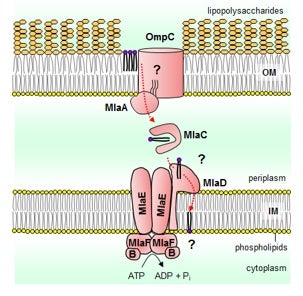Outer membrane stability, and assembly processes
CHNG Shu Sin (Group Leader, Chemistry) () May 03, 201603 May 2016 NUS scientists have identified bacterial osmoporin OmpC as a functional component of the system that maintains outer membrane lipid asymmetry.
Gram-negative bacteria possess an asymmetric outer membrane that serves as a permeability barrier against external insults, including antibiotics. The outer and inner leaflets of the membrane comprise lipopolysaccharides and phospholipids, respectively. Lipid asymmetry is perturbed when phospholipids somehow end up in the outer leaflet. It is still not clear how lipid asymmetry is established and maintained; however, a system known as the Mla (Maintenance of lipid asymmetry) pathway has been implicated in the latter process.
Prof CHNG Shu Sin and graduate student Mr CHONG Zhi Soon from the Department of Chemistry in NUS have now discovered that an outer membrane protein OmpC is also important for maintaining outer membrane lipid asymmetry in Escherichia coli. This protein forms a complex with the outer membrane lipoprotein MlaA (a known component of the Mla pathway) and may help MlaA extract phospholipids aberrantly accumulated in the outer leaflet of the outer membrane. OmpC is a channel that allows bacteria to acquire nutrients from its environment. This work has revealed a previously unknown function for OmpC in phospholipid transport.
Only a few antibiotics are effective against infections caused by Gram-negative bacteria due to the presence of the outer membrane. With the rapid emergence of drug-resistant bacteria, there is an ever urgent need to develop new antibiotics. Because the outer membrane keeps many antibiotics out of the cell, an interesting approach to overcome drug resistance is to disrupt outer membrane stability and assembly processes. Understanding how outer membrane lipid asymmetry is maintained (via the OmpC-Mla pathway) may thus provide useful insights towards this effort. Going forward, the NUS team will study the structure of the OmpC-MlaA complex to elucidate the molecular mechanism of phospholipid transport at the outer membrane.

Figure shows a schematic diagramme of the Gram-negative cell envelope and the function of the OmpC-Mla pathway in maintaining lipid asymmetry. The OmpC-MlaA complex may function to extract phospholipids from the outer leaflet of the outer membrane (OM), which are then transported back to the inner membrane (IM) via the rest of the Mla pathway. [Image credit: Chng Shu Sin]
Reference
Chong ZS, Woo WF, Chng SS. “Osmoporin OmpC forms a complex with MlaA to maintain outer membrane lipid asymmetry in Escherichia coli.” Mol. Microbiol. (2015) 98:1133.


